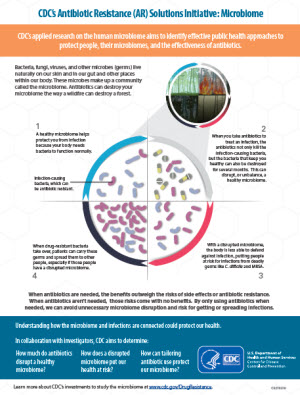Innovations to Slow Antibiotic Resistance
What CDC is Doing
CDC encourages and invests in innovation focused on new strategies, drugs, and diagnostics to combat antibiotic resistance. Overall, this work enhances current practices and supports discovery of new solutions that can protect people from this global threat.
This work complements additional CDC antibiotic resistance investments, collectively known as CDC’s Antibiotic Resistance (AR) Solutions Initiative. Through these investments, CDC is transforming how the nation combats and slows antibiotic resistance at all levels.
Information for Research and Development
The CDC and FDA AR Isolate Bank provides information on resistance to support innovation in diagnostics and drug development. CDC has one of the largest collections of isolates (pure samples of a germ), and provides these isolates to approved institutions through the AR Isolate Bank. This work ultimately improves patient care and builds solutions against resistance threats.
Insights for Practice
CDC invests in innovations and collaborates with investigators to identify and implement new ways to prevent antibiotic-resistant infections and their spread. This innovative work explores the connection between antibiotic resistance within healthcare settings, the human microbiome, and agriculture and the environment. Data from these projects will help CDC better protect people by, for example, uncovering places resistant germs live and spread, improving outbreak response, and strengthening infection prevention practices.
Healthcare Settings
CDC works with networks of trusted partners to discover, implement, and evaluate innovative prevention strategies to improve healthcare quality and patient safety. In collaboration with investigators, CDC aims to determine:
- How Antibiotic Stewardship Programs Can Protect Patients: Assessing how programs focused on improving antibiotic use will improve patient safety
- How Enhancing Infection Control Actions can Prevent Spread of Infections:
- Evaluating new strategies, like enhanced cleaning methods
- Implementing and measuring the impact of setting-specific prevention strategies (like those developed specifically for nursing homes)
- Discovering innovative infection control and prevention methods that could be refined and applied nationwide
- How to Obtain Better-Quality Data for Action: Gathering more infection data from healthcare facilities to better measure the challenges influencing healthcare quality and patient safety, and implement solutions (like modeling how healthcare-associated infections are transmitted within healthcare facilities and in the community)
Human Microbiome
CDC is conducting applied research on the microbiome—a community of naturally-occurring germs in and on our bodies—to identify effective public health approaches that protect people, their microbiomes, and the effectiveness of antibiotics. In collaboration with investigators, CDC aims to determine:
- How Antibiotics Disrupt a Healthy Microbiome: Studying novel strategies that can protect and restore the microbiome, and determine how exposure to antibiotics early in life affects microbiome development
- How a Disrupted Microbiome Puts People at Risk:
- Developing a predictive index that identifies a patient’s risk of disruption from a specific antibiotic, a patient’s likelihood of becoming a carrier of antibiotic-resistant bacteria, and their risk of becoming infected with one
- Developing and test microbiome measurements that monitor a patient’s risk for carrying and transmitting antibiotic-resistant bacteria and assess enhanced infection control triggers
- How Improving Antibiotic Use Can Protect the Microbiome: Improving strategies to tailor antibiotic stewardship to a patient’s individual microbiome, and assessing how to fit antibiotic stewardship to a specific population of patients (like a nursing home or doctor’s office)
Agriculture and the Environment (surface water and soil)
CDC is addressing knowledge gaps around antibiotic resistance in the environment and its potential risk to human health. In collaboration with investigators, CDC aims to determine:
- How Antibiotic-resistant Bacteria and Antibiotics can Spread through the Environment:Detecting and determining the amount of resistance elements (mechanisms like a gene that can share resistance) in aquatic ecosystems where wastewater is discharged or runoff can leach into the soil and water, and the potential risk to human health
- Data to Understand the Risk to Human Health: Working towards identifying antibiotic residue and resistance elements in aquatic ecosystems near healthcare and agriculture settings, and quantifying concentrations at which resistance might emerge to better understand the risk posed to human health
Printable Fact Sheets
Find more AR Solutions Initiative materials on the Fact Sheets and Graphics webpage.























.png)











No hay comentarios:
Publicar un comentario